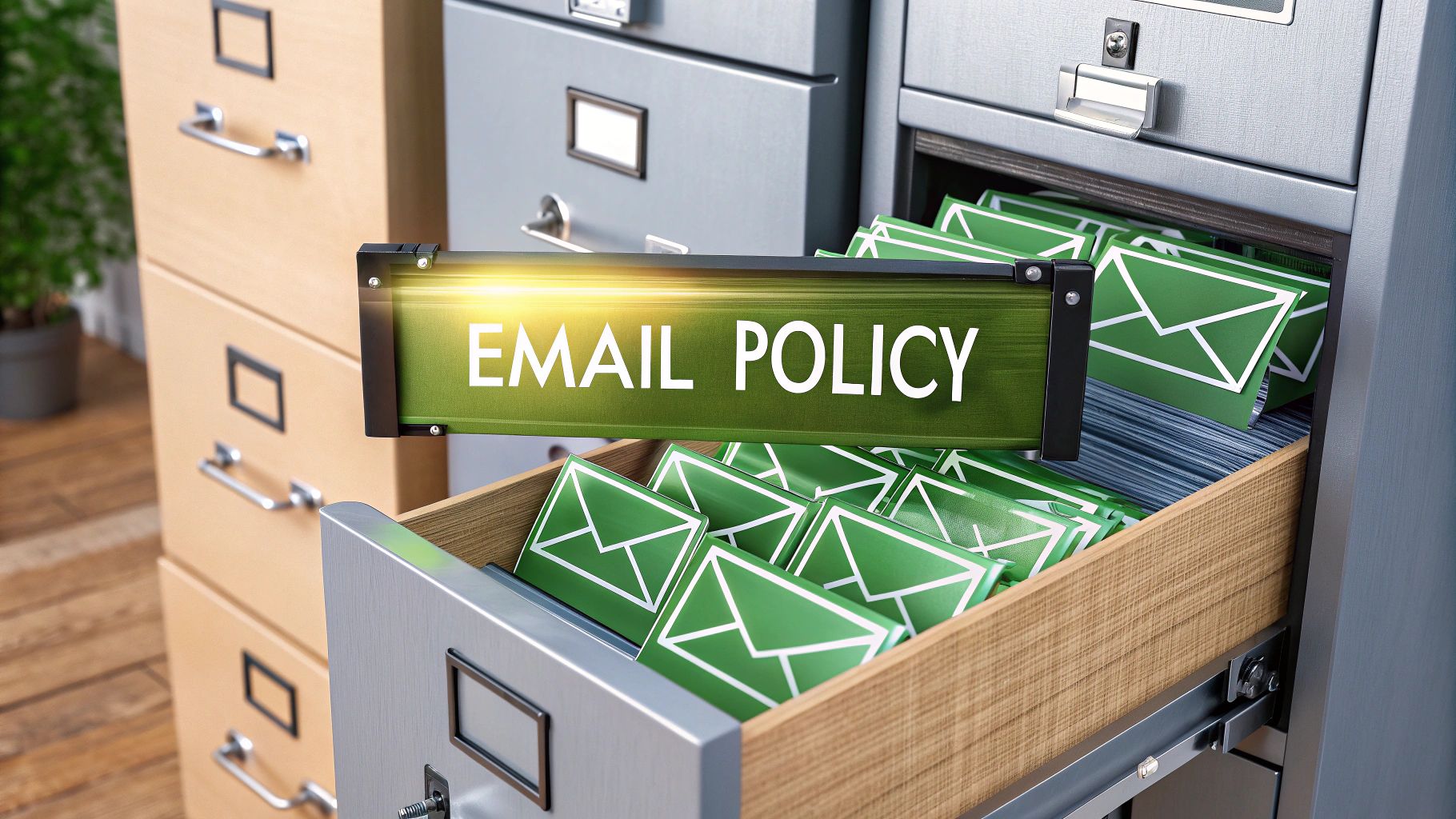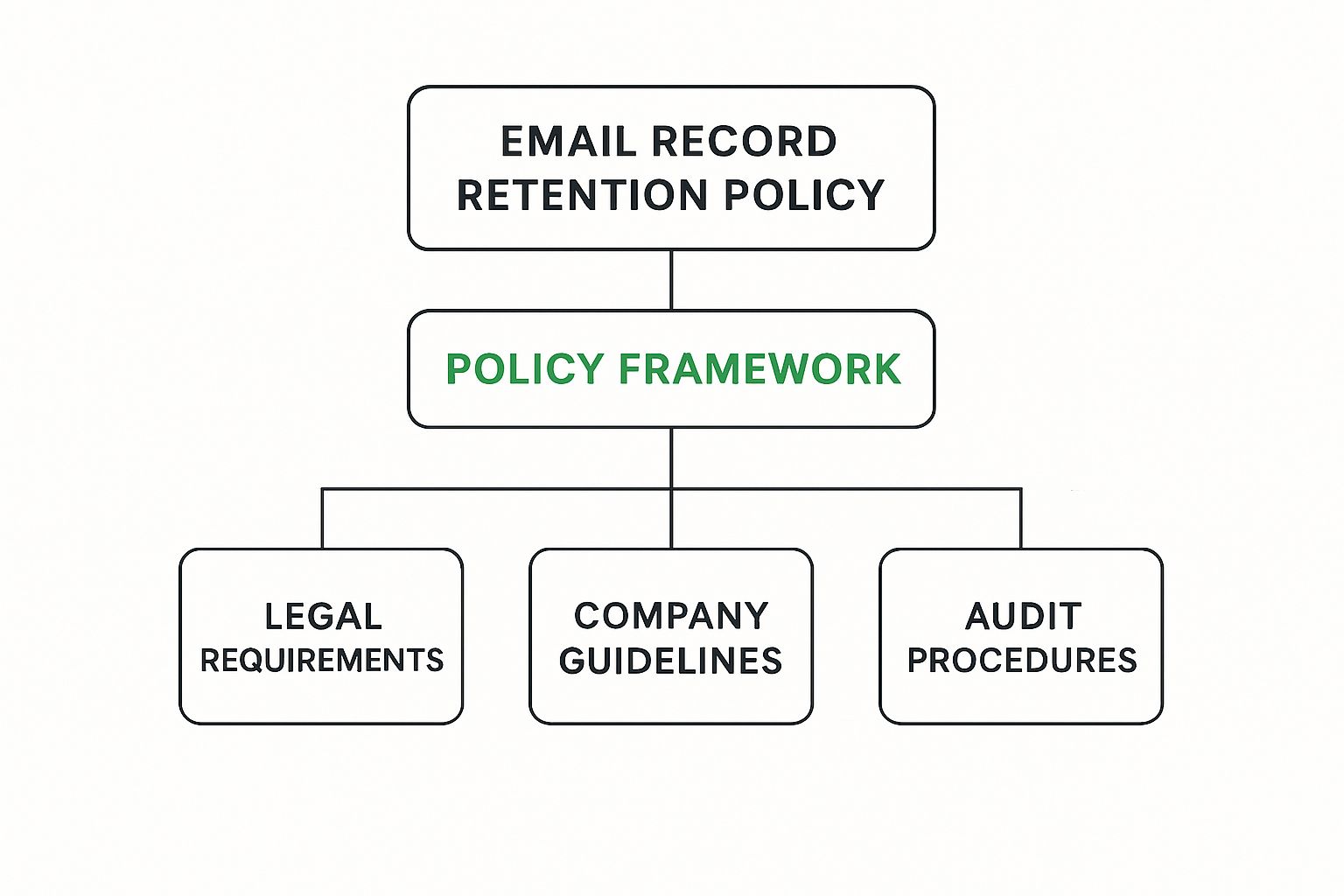Email Record Retention Policy: Your Complete Guide

Why Your Email Record Retention Policy Matters More Than Ever

Think of your company's email server as a gigantic, ever-growing digital filing cabinet. Every single message, from a crucial contract negotiation to a simple lunch invitation, gets stored inside. Without a system, this cabinet quickly becomes a messy and risky liability. An effective email record retention policy is the blueprint that dictates what to keep, for how long, and when you can safely get rid of it. This turns your email from a chaotic data swamp into a structured and searchable business resource.
Many organizations fall into two equally dangerous traps: keeping everything forever or deleting messages without a clear plan. The "keep everything" approach might seem safe, but it inflates storage costs and dramatically expands what you have to review during a legal process. On the other hand, deleting too soon can lead to the destruction of vital evidence or business records, resulting in serious legal and financial consequences. A formal policy creates a sensible and defensible middle ground.
The Hidden Costs of Poor Email Management
Letting your email archives grow unchecked causes more than just disorganization. The risks are real and can directly affect your bottom line, reputation, and daily operations. Without a clear email record retention policy, your business is exposed to several hidden costs:
- Increased Legal Exposure: In a lawsuit or audit, you are required to produce relevant electronic records. Having to sort through years of unmanaged emails is an expensive and slow process. Even worse, failing to produce a specific email can result in court penalties.
- Wasted Storage Resources: Uncontrolled email growth eats up valuable server space, leading to higher IT infrastructure costs. A surprising 85% of all stored data is often redundant, obsolete, or trivial, which means companies are paying to store information with no real value.
- Productivity Drain: Employees can waste hours searching for specific information lost in cluttered inboxes. A well-organized archive, guided by a retention policy, makes finding important communications quick and straightforward.
This screenshot from a Wikipedia article about email archiving shows the architecture of a typical system.

The diagram shows how emails are captured, processed by policy engines, and stored in a secure archive. It makes it clear that the policy is the central "brain" of the whole operation. This demonstrates that a policy isn't just a document; it's the core logic that powers the entire email management and archiving process, making it a critical technical component.
From Reactive Compliance to Strategic Advantage
A well-designed email record retention policy is more than just a defensive move; it's a strategic tool. The sheer volume of digital communication makes it a key part of corporate information governance. Global daily email traffic is expected to reach about 392 billion in 2025 and climb to over 523 billion by 2030.
By actively managing this flood of data, your organization can transform a potential liability into a real asset. You can explore more about this growth by reviewing these email archiving statistics. This structured approach ensures you are prepared for legal challenges, compliant with regulations, and operating at peak efficiency, positioning your organization for the future instead of just reacting to problems.
Decoding The Maze of Legal Requirements
Figuring out email retention laws can feel like solving a complex puzzle where the rules shift based on your industry and where you do business. What's required for a financial firm in New York might be completely different from the rules for a healthcare provider in Europe. The main thing to grasp is that your email record retention policy isn't just one document; it's a framework designed to meet multiple, sometimes conflicting, legal demands.
One common challenge is the tension between keeping data for legal reasons and respecting data privacy. For instance, a U.S. financial company under SEC rules must keep detailed records for years. But if that same company serves European customers, it also has to follow GDPR's "right to be forgotten," which lets people ask for their personal data to be deleted. A smart policy handles this by clearly classifying data, which helps the system know which emails must be saved and which can be deleted upon request.
A solid email record retention policy is usually built on a few key pillars. The image below shows this layered approach.

This structure demonstrates that a strong policy starts with legal requirements, is reinforced by your own company's rules, and is checked through regular audits. This makes your policy a living system that can adapt to new laws and business needs, finding a good balance between compliance and practicality.
Industry-Specific Retention Mandates
How long you need to keep emails can vary wildly from one industry to another. There’s no single answer; the right retention period depends on the specific regulations that apply to your business. While some general business records might only need to be kept for three years, companies in highly regulated sectors face much stricter timelines. Relying on a generic policy here can quickly lead to non-compliance and big fines.
To give you an idea of how different these requirements are, here's a quick comparison of email retention periods for various industries.
| Industry | Regulation | Minimum Retention Period | Key Requirements |
|---|---|---|---|
| Healthcare | HIPAA | 6 years | Applies to records with protected health information (PHI). The clock starts from the date of creation or its last effective date. |
| Financial Services | FINRA/SEC | 6 years | Broker-dealers must keep business communications, with the first 2 years in a format that's easy to access. |
| Government Contractors | DOD | 3 years | Pertains to project-related communications, with the retention period starting after the final contract payment. |
| Publicly Traded Companies | SOX | 5 years | Covers records related to audits and reviews, including relevant electronic communications. |
Comparison of minimum retention periods across different regulated industries
As the table shows, these aren't just suggestions—they are firm legal requirements. Getting these timelines wrong can lead to fines that can reach into the millions, making it critical to know exactly what rules your industry must follow.
The Global Regulatory Picture
Global regulations add another layer of complexity, often presenting unique challenges. Regulatory bodies around the world set their own specific rules for keeping and deleting data, and sometimes these policies can seem contradictory. A case in point involved the UK's Financial Conduct Authority (FCA), which came under fire for a new policy to automatically delete some emails after just 12 months. Although the goal was to manage data volume, this move showed the tricky balance between administrative efficiency and the need for long-term records. You can learn more about the FCA’s controversial email deletion policy and the criticism it faced.
This example highlights how important it is to have a policy that is both defensible and in line with regional expectations. For businesses that operate internationally, your email record retention policy needs to be flexible enough to handle these different jurisdictional rules without causing an operational headache.
Managing The Email Volume Explosion

Your organization's email traffic is growing faster than ever, and old-school storage methods just can't handle it. Picture trying to catch a waterfall with a teacup; it's an impossible task. This isn't just a few extra messages—it's a constant stream of communication, with each email potentially being a critical business record or legal document. Recognizing the sheer size of this challenge is the first step toward creating a practical email record retention policy.
This reliance on email is a global phenomenon. By 2025, the number of worldwide email users is expected to reach 4.83 billion, which is nearly 60% of the planet's population. This huge user base generates an immense amount of data that companies are responsible for managing. You can find more details about these trends by exploring some current email usage statistics. For any business, this means that without a clear plan, storage costs and legal vulnerabilities will only increase.
Calculating The Real Cost Of Long-Term Storage
The expense of keeping emails goes far beyond just buying server space. The "keep everything forever" strategy might seem like the safest bet, but it comes with major hidden costs. Think of it like a self-storage unit: the more junk you cram in, the more you pay in rent, and the harder it is to find anything you actually need. For email, these hidden costs include:
- Infrastructure and Maintenance: Constantly expanding physical or cloud storage to handle endless data growth.
- eDiscovery Expenses: Legal teams sifting through mountains of irrelevant data, where review costs can eat up over 70% of litigation budgets.
- Security Risks: The more data you hold, the larger the target you present for potential security breaches.
Forward-thinking organizations are shifting their perspective from just storing data to actively managing it. They figure out the true cost by including these extra expenses, often discovering that a well-planned email record retention policy delivers a strong return on investment.
Smart Strategies For Scaling Efficiently
To avoid being buried in data, smart organizations use modern strategies to manage email volume effectively. This isn't about endlessly buying more storage; it's about being more intelligent with the resources you already have. This usually means taking a combined approach.
| Strategy | Description | Key Benefit |
|---|---|---|
| Intelligent Archiving | Automatically shifts emails from expensive primary servers to a more affordable, secure archive based on rules like age or content. | Lowers the burden on primary storage and cuts costs while keeping emails accessible for the long haul. |
| Automated Classification | Uses rules or AI to categorize emails based on their content, sender, or regulatory importance (e.g., "Financial," "HR," "Legal"). | Allows for different retention schedules for different kinds of data, helping to maintain compliance. |
| Tiered Storage | Places data on different types of storage media based on how often it's needed, from fast, pricey drives to slower, cheaper long-term options. | Optimizes storage expenses by matching the cost of the medium to the value and access needs of the data. |
By using these methods, some organizations have successfully reduced their email storage costs by as much as 70%. More importantly, they improve their compliance standing and make it much simpler to locate essential information when it counts. This active management approach turns the email explosion from a major headache into a manageable part of your information governance plan.
Building Your Policy Framework That Actually Works
Crafting a solid email record retention policy is not about downloading a generic template and hoping for the best. Think of it like building a house: you wouldn't use a blueprint for a cozy beach cottage to construct a sprawling mountain lodge. Your policy must be designed specifically for your organization’s structure, industry rules, and daily operations.
A truly effective policy finds a balance between competing needs—legal requirements versus storage costs, and security demands versus business efficiency. It needs to be a practical guide that your teams can actually understand and use. Simply hoping employees will manage their own inboxes is a recipe for disaster. This passive approach almost guarantees that a crucial email will be missing when you need it most for a lawsuit or an audit.
Core Components of a Defensible Policy
A strong policy is built on several key pillars that work together to provide clarity and ensure compliance. If you miss any of these, you create gaps that can lead to confusion and unnecessary risk. For your framework to be sturdy, it needs to clearly define a few essential elements.
- Scope and Purpose: State exactly what the policy covers (e.g., all internal and external emails, specific attachments) and why it exists (e.g., to meet regulatory requirements, manage storage costs, or simplify eDiscovery).
- Retention Schedules: This is the heart of your policy. It defines specific timeframes for how long different types of emails must be kept, which requires careful categorization of your data.
- Roles and Responsibilities: Clearly assign ownership. Who is responsible for what? This includes roles for IT administrators, legal and compliance officers, and every employee. When roles are clear, important tasks don't get overlooked.
- Legal Hold Procedures: Detail the exact steps to follow when litigation is on the horizon. This process must override standard deletion schedules to preserve all relevant data without fail.
- Enforcement and Auditing: Explain how the policy will be monitored, what the consequences are for non-compliance, and how often it will be audited. Regular checks keep the policy effective.
Categorizing Emails for Sensible Retention
Applying a single retention period to all emails is a common and expensive mistake. Not all emails are created equal; a quick project update has a different lifespan and value than a signed contract. The key is to create clear retention categories that are easy for employees to understand and for automated systems to manage.
For example, you could set up categories like "Transient Communications" (e.g., meeting invites, newsletters) with a 30-day retention, "General Business Correspondence" with a 3-year retention, and "Legal and Financial Records" with a 7-year or longer period, depending on rules like SOX or HIPAA. This tiered system helps control data volume and reduces risk, making it a cornerstone of a smart email record retention policy. You can learn more about how this connects to broader security in our guide on setting up data loss prevention for email.
To help you cover all your bases, here is a checklist of essential components for your email retention policy.
| Component | Purpose | Implementation Priority | Compliance Impact |
|---|---|---|---|
| Policy Scope | Defines which communications and data types are covered under the policy. | High | Critical for establishing clear legal and operational boundaries. |
| Retention Categories | Sets different retention timelines for various types of email content. | High | Essential for balancing compliance obligations with storage costs. |
| Legal Hold Process | Outlines the mandatory steps for preserving data relevant to litigation. | Critical | Non-negotiable for legal defensibility and avoiding sanctions. |
| Deletion Protocol | Defines the secure, documented, and automated process for data disposal. | Medium | Reduces liability and risk by defensibly eliminating unneeded data. |
| Employee Training | Ensures all staff understand their duties and the policy's importance. | High | Crucial for successful adoption, enforcement, and creating a culture of compliance. |
| Regular Review Cycle | Establishes a schedule for updating the policy to reflect new regulations or business needs. | Medium | Ensures the policy remains relevant, effective, and compliant over time. |
Essential elements every email retention policy must include for comprehensive coverage
By building your policy around these structured components, you create more than just a document—you build a functional system. This framework not only satisfies regulators but also becomes a valuable asset for managing information, reducing risk, and supporting your organization’s long-term health.
Choosing Technology That Grows With You

The ideal technology for your email record retention policy should work like a skilled digital assistant, handling the repetitive tasks while you maintain control. The market is full of solutions promising everything from AI-powered classification to infinite storage. To find the right fit, you need to focus on what supports your policy’s goals, not just on flashy features you might never use. The first major choice is deciding where your data will be stored: on your own servers or in the cloud.
On-premises solutions offer direct, physical control over your hardware, which some organizations prefer for security. This path, however, requires a large initial investment, ongoing maintenance, and purchasing more servers to scale. Cloud-based archiving provides flexibility and scalability, letting you pay for what you need and easily expand as your data grows. For many companies, the cloud is a more cost-effective and manageable option.
Key Features That Deliver Real Value
When looking at technology, it's easy to get overwhelmed by a long list of features. A great platform isn't about having the most functions; it's about having the right ones to support your email record retention policy. Think of it like buying a professional camera—you need high-quality lenses and sensors, not a dozen novelty filters.
Here are the features that matter most:
- Automated Policy Enforcement: The system should apply your retention rules automatically, without needing someone to click a button. This ensures consistency and removes the risk of human error.
- Granular Search and eDiscovery: When a legal or compliance request comes in, you need to find specific emails fast. A powerful and easy-to-use search function that filters by date, sender, keywords, and other details is essential.
- Immutable Storage: To protect data integrity, archived emails must be stored in a way that prevents them from being changed or deleted before their retention period is over. This is critical for legal situations.
- Comprehensive Auditing: The platform must keep detailed logs of every action, from who accessed the data to when policies were changed or emails were deleted. This creates a clear audit trail for compliance.
The Role of AI and Machine Learning
Artificial intelligence and machine learning are changing how organizations manage email. Instead of just using manual rules, these systems can learn to recognize and sort messages with impressive accuracy. For example, AI can be trained to spot contracts, invoices, or HR messages based on their content and automatically apply the correct retention schedule.
This technology can process millions of messages, reducing the workload for IT and compliance teams and making your email record retention policy much more accurate. It also improves data security. By learning what normal communication looks like, AI can flag unusual activity that might signal a security breach. You can learn more about this proactive approach in our complete guide to defending against email security threats. As your organization grows, a platform with intelligent automation will be better prepared for future challenges than one that relies on static, old methods.
Rolling Out Your Policy Without Chaos
Crafting a brilliant email record retention policy is a major milestone, but it's only half the journey. The real test is in the implementation. Think of your new policy as a powerful new software application; without a proper installation and user training, it’s likely to create more problems than it solves. A chaotic rollout can spark employee resistance, inconsistent use, and ultimately, cause the entire policy to fail. The goal is to introduce these changes thoughtfully, turning a potentially disruptive mandate into a smooth operational upgrade.
The most successful rollouts are treated like strategic projects, not just another IT task. The focus is on clear communication, getting key people on board, and providing useful training to make sure the policy is understood and adopted by everyone.
Gaining Buy-In and Communicating Change
Before a single rule is enforced, you need to build a solid foundation of understanding and support. Simply issuing a top-down decree without any context is the quickest way to create friction. Instead, start by explaining the "why" behind the policy.
Frame the new email record retention policy not as a restrictive set of rules, but as a protective measure for both the company and its employees. Explain how it helps to:
- Reduce legal risk by ensuring the company follows industry regulations.
- Improve productivity by making important information easier to locate.
- Lower costs by getting rid of unnecessary data storage fees.
This approach shifts the conversation from a burden to a shared responsibility. You can hold informational sessions, create simple, easy-to-read guides, and give teams a forum to ask questions. When employees see the benefits for themselves, they are much more likely to become active participants instead of roadblocks. It’s worth noting that while 80% of companies have data retention policies, only about a third consistently enforce them—a gap often created by poor communication and a lack of employee buy-in.
Training and Accountability
Clear communication needs to be followed by practical training. Don't just send an email with a policy document attached and hope for the best. Good training should be ongoing and customized for different roles within the organization.
| Role | Training Focus | Accountability Metric |
|---|---|---|
| All Employees | Basic policy rules, how to classify common emails, and why compliance matters. | Following standard retention schedules for their own mailboxes. |
| Managers | Deeper knowledge of departmental duties and how to manage specific record types. | Quarterly review of their team's compliance and data management. |
| IT & Legal Teams | Technical enforcement, procedures for legal holds, and audit protocols. | Successful execution of legal holds and clean internal audit reports. |
Training and accountability should be tailored to each role.
Accountability is what makes the policy truly stick. It’s not about punishing people for mistakes, but about fostering a culture of responsibility. Regular, low-stress audits can help pinpoint areas where employees might be struggling, creating opportunities for more targeted retraining. By setting up monitoring systems, you can catch issues early and make ongoing improvements. This proactive method ensures your email record retention policy remains a living, effective tool rather than a forgotten document in a company handbook.
Learning From Others' Expensive Mistakes
Sometimes the most valuable business lessons come from studying failures. When it comes to an email record retention policy, even well-intentioned plans can go wrong, leading to expensive consequences. Examining these missteps is like learning defensive driving—it helps you anticipate dangers and build safeguards into your own strategy before a crisis hits.
One of the most frequent errors is creating a policy that is either too rigid or too vague. A policy that's overly complex with dozens of confusing categories often gets ignored by employees, making it useless. On the other hand, a policy that is too simple, like a blanket "delete everything after one year" rule, risks accidentally destroying critical records that are legally required to be kept longer. This can lead to massive fines and sanctions during legal discovery.
The Peril of Inconsistent Enforcement
Another common pitfall is inconsistent enforcement. Many organizations document a solid policy but fail to implement the technology or training to ensure it's followed. It's like posting a speed limit sign but never having a patrol car in sight. This creates a dangerous gap between what the policy says and what actually happens.
This inconsistency becomes a major liability during an audit or legal case. If you can't prove you consistently followed your own rules, regulators and opposing counsel may argue that your policy is a sham, designed only for appearances. The result? You lose the legal protection the policy was created to provide. In fact, while a large percentage of companies report having a data retention policy, it's estimated that only about a third consistently enforce data disposal timelines, exposing the other two-thirds to significant risk.
Avoiding Common Policy Traps
To build a resilient email record retention policy that avoids these common failures, you need to focus on both the rules and their practical application.
- Handle Edge Cases Proactively: Don't wait for a crisis to decide how to handle unique situations. Your policy should include clear procedures for exceptions, such as placing data on a legal hold or managing privileged communications.
- Balance Simplicity and Detail: Create retention categories that are detailed enough for compliance but simple enough for employees to understand and apply correctly. Use automation to handle the classification whenever possible.
- Audit and Adapt: Regularly review your policy's effectiveness. Are employees following it? Is the technology working as intended? An annual review ensures your policy evolves with your business and the regulatory environment.
By learning from these expensive mistakes, you can design a policy that is not just compliant on paper, but truly effective in practice.
A strong policy requires reliable technology to back it up. Typewire offers secure, private email hosting that gives you full control over your data. With robust security and no data mining, you can manage your communications with confidence. Explore Typewire's features and start your free trial today.
Email Record Retention Policy: Your Complete Guide
Posted: 2025-06-23
Data Residency Requirements for Secure Hosted Email
Posted: 2025-11-29
Your Data Breach Response Plan for Hosted Email Security
Posted: 2025-11-28
PGP Encryption Online: A Guide to Secure Email
Posted: 2025-11-27
What Is a Digitally Signed Email?
Posted: 2025-11-26
How to host email server for privacy and security
Posted: 2025-11-25
what is a mail server: A guide to email privacy and security
Posted: 2025-11-24
What Is Email Hosting and Why Does It Matter?
Posted: 2025-11-23
Hosting a Mail Server: A Practical Guide to Email Privacy and Security
Posted: 2025-11-22